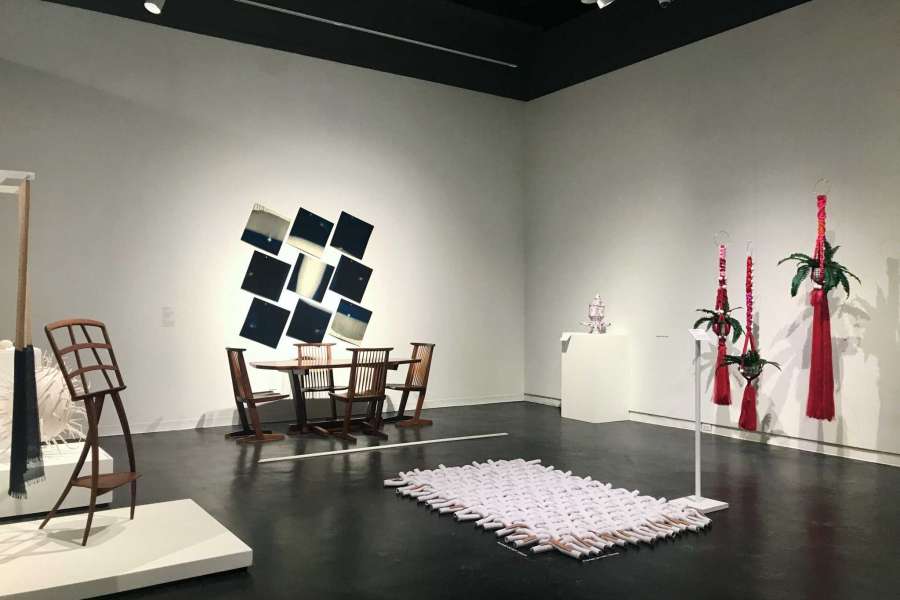
My husband, Don’s, worst nightmare was hanging there, against a long wall at the Houston Center for Contemporary Craft: a trio of macramé plant hangers. Really big ones, decorated with beads, holding ferns and casting ominous shadows.
Some people are repulsed by clowns or monkeys. Don has that kind of relationship with macramé plant hangers. We do not discuss the crafty, 1970s part of my life, pre-Don, that involved crocheting macramé plant holders myself and hanging them in windows. Nor do I taunt him with catalogs from companies such as Anthropologie or CB2 that have helped fuel the macramé-plant-hanger renaissance on Instagram and Pinterest. He lives in fear that I will relapse.
So of course Jennifer Ling Datchuk’s “Loving Care” caught my eye in the show “Objects: Redux – How 50 Years Made Craft Contemporary.”
Datchuk, who lives in San Antonio, is a multidisciplinary artist on the rise who explores issues of gender, race and identity. The porcelain beads decorated with hearts woven into her plant hangers are not random design elements. They’re sprung from the wrought history of Chinese porcelain and Datchuk’s own, biracial story. The long tassels are made of fake hair, another material she employs when she is thinking about concepts of beauty.
Datchuk’s installation looks like one of the smartest things in a show that aims to reflect on the legacy of a seminal 1969 exhibition of American studio craft. She made “Loving Care” this year, but the title is a pun on a brand of hair color that was popular 50 years ago. This makes me think Datchuk created her plant hangers in response to the show’s theme.
This has been a year of 1969 all over again, as cultural institutions commemorate a slew of transformative moments that happened a half-century ago, including the Apollo 11 moon landing, Woodstock and Stonewall riots. Far fewer people remember the Smithsonian’s influential “Objects: USA” show, which toured the United States and Europe that year.
It signaled how craft, once defined as functional art – vessels, furniture, jewelry and such – had shifted into higher gear with works that pushed technical boundaries and explored the histories of mediums. Museums took notice and began collecting contemporary jewelry and works in enamel, ceramics, glass, metal, plastic, mosaic, wood and fiber, elevating craft to the context of fine art and design.
Referencing “Objects: USA” now is probably more helpful to scholars and collectors than the general public. But people are still trying to define what craft can mean because object-making technologies continually evolve. Houston Center director Perry Price and curator Kathryn Hall aim to bridge history by displaying works by 21 artists who appeared in the 1969 show and 24 newer-generation talents.
Making sense of it all is a challenge. If there’s a timeline, it’s lost in the shuffle of works in all scales and materials across the center’s large, wide-open gallery.
I wanted to compare the kinds of early-career objects glass artists such as Dale Chihuly and Harvey Littleton were making in the early 1980s to works others are producing now – Matthew Szösz’s inflated glass objects, for example. He harnesses accidents, playing with physics and chance to create his blown-glass pieces. The narrative is there, just not easy to see because those works are not displayed near each other.
Maybe there’s a concept related to influences? One end of the gallery seems more focused on the hand-made, and the other contains pieces that push boundaries and rely on recent technology. Take two works based on nature and made with glass: Hiromi Takizawa’s exquisitely colored “stones” look like they could have been picked up on a mountain trail in Japan. Norwood Viviano’s nesting cylinders, which are just as perfect in their way, visualize flood data in a half-dozen cities.
The question of intent also ripples across the room. Among many contemporary craft artists who are still focused on material experimentation, Christy Matson investigates the expressive possibilities of fiber, using Japanese paper yarn that she paints and weaves, working with a programmable loom. Her 2018 tapestry “Optics” hangs next to Ted Hallman’s traditional wool and cotton “Textile,” from 1958.
Other studio craft artists today concentrate on social issues as much as techniques. Metalworker Holland Houdek portrays breast implants and artificial hearts as jewellike luxuries available only to the wealthy. Along with Datchuk, Nicki Green and Robert Lugo employ traditional ceramic practices to explore the histories of marginalized communities. Green’s “Operating in Bright Sunlight” celebrates gender-reassignment surgery on a Delftware-inspired vessel resembling a tulip vase. Lugo’s “Colin and a Queen” vessel combines ancient shapes with an image of the controversial football player Colin Kaepernick.
From a form-and-materials perspective, the show glimpses the evolution of sculptural furniture: Wendell Castle’s curvaceous black fiberglass “Molar Couch,” from 1965, looks classic and very much of its snazzy time. It stands within sight of Vivian Beer’s 2014 “Twin Engine,” a bench of formed and fabricated steel with automotive finish, referencing the aviation-inspired fins of a vintage Cadillac; and Annie Evelyn’s intentionally gaudy selfie station chair, “The Hideous New Beautiful Reality.”
“Objects: Redux” could benefit from some drama, or at least more walls, to enable more cohesive groupings.
I gravitated toward “Loving Care” partly because it hangs in the show’s best-looking corner, where objects have more breathing room. The curators created a clean vignette there, evoking a serene, domestic setting I wouldn’t mind inhabiting.
The big pieces in that mix are George Nakashima’s Japanese-meets-Shaker walnut and rosewood “Conoid Table,” from 1979; Tanya Aguiñiga’s 2014 “Tierra,” a nylon rug woven of soil-filled tubes from both sides; and Wharton Esherick’s elegant cherry-wood “Music Stand,” from 1962 – works from different eras, looking timeless and playing nice together.
Aside from the macramé plant hangers, I think my husband would approve.
molly.glentzer@chron.com

